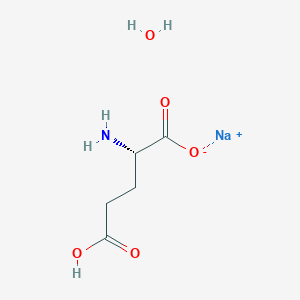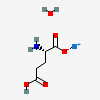Sodium (S)-2-amino-4-carboxybutanoate hydrate
- 6106-04-3
- Sodium (S)-2-amino-4-carboxybutanoate hydrate
- Sodium L-glutamate hydrate
- MONOSODIUM GLUTAMATE
- L-Glutamic acid monosodium salt hydrate
- Create:2008-02-05
- Modify:2025-01-18


- Accent
- Glutamate, Sodium
- Monosodium Glutamate
- MSG
- Sodium Glutamate
- Vestin
- 6106-04-3
- Sodium (S)-2-amino-4-carboxybutanoate hydrate
- Sodium L-glutamate hydrate
- MONOSODIUM GLUTAMATE
- L-Glutamic acid monosodium salt hydrate
- SodiuM L-GlutaMate Monohydrate
- L-Glutamic acid (monosodium) (hydrate)
- Sodium L-glutamate
- Monosodium glutamate monohydrate
- SCHEMBL317907
- CHEMBL3182385
- DTXSID0047240
- AKOS024464822
- CS-W016861
- HY-W016145
- SODIUM HYDROGEN GLUTAMATE HYDRATE
- AS-81611
- NS00134124
- sodium;(2S)-2-amino-5-hydroxy-5-oxopentanoate;hydrate
Not Classified
Reported as not meeting GHS hazard criteria by 25 of 25 companies. For more detailed information, please visit ECHA C&L website.
Aggregated GHS information provided per 25 reports by companies from 1 notifications to the ECHA C&L Inventory.
Reported as not meeting GHS hazard criteria per 25 of 25 reports by companies. For more detailed information, please visit ECHA C&L website.
There are 0 notifications provided by 0 of 25 reports by companies with hazard statement code(s).
Information may vary between notifications depending on impurities, additives, and other factors. The percentage value in parenthesis indicates the notified classification ratio from companies that provide hazard codes. Only hazard codes with percentage values above 10% are shown.
SYMPTOMS: Large oral doses in humans have provoked burning sensation, facial pressure, chest pains, dyspnea, somnolence, hallucinations, distorted perceptions, nause and vomiting. Susceptible individuals may experience an allergic response.
ACUTE/CHRONIC HAZARDS: This compound emits toxic fumes when heated to decomposition. (NTP, 1992)
EYES: First check the victim for contact lenses and remove if present. Flush victim's eyes with water or normal saline solution for 20 to 30 minutes while simultaneously calling a hospital or poison control center. Do not put any ointments, oils, or medication in the victim's eyes without specific instructions from a physician. IMMEDIATELY transport the victim after flushing eyes to a hospital even if no symptoms (such as redness or irritation) develop.
SKIN: IMMEDIATELY flood affected skin with water while removing and isolating all contaminated clothing. Gently wash all affected skin areas thoroughly with soap and water. If symptoms such as redness or irritation develop, IMMEDIATELY call a physician and be prepared to transport the victim to a hospital for treatment.
INHALATION: IMMEDIATELY leave the contaminated area; take deep breaths of fresh air. If symptoms (such as wheezing, coughing, shortness of breath, or burning in the mouth, throat, or chest) develop, call a physician and be prepared to transport the victim to a hospital. Provide proper respiratory protection to rescuers entering an unknown atmosphere. Whenever possible, Self-Contained Breathing Apparatus (SCBA) should be used; if not available, use a level of protection greater than or equal to that advised under Protective Clothing.
INGESTION: DO NOT INDUCE VOMITING. If the victim is conscious and not convulsing, give 1 or 2 glasses of water to dilute the chemical and IMMEDIATELY call a hospital or poison control center. Be prepared to transport the victim to a hospital if advised by a physician. If the victim is convulsing or unconscious, do not give anything by mouth, ensure that the victim's airway is open and lay the victim on his/her side with the head lower than the body. DO NOT INDUCE VOMITING. IMMEDIATELY transport the victim to a hospital. (NTP, 1992)
SMALL SPILLS AND LEAKAGE: If you spill this chemical, you should dampen the solid spill material with water, then transfer the dampened material to a suitable container. Use absorbent paper dampened with water to pick up any remaining material. Seal your contaminated clothing and the absorbent paper in a vapor-tight plastic bag for eventual disposal. Wash all contaminated surfaces with a soap and water solution. Do not reenter the contaminated area until the Safety Officer (or other responsible person) has verified that the area has been properly cleaned.
STORAGE PRECAUTIONS: You should store this material in a refrigerator. (NTP, 1992)
IMAP assessments - L-Glutamic acid, monosodium salt, monohydrate: Human health tier I assessment
IMAP assessments - L-Glutamic acid, monosodium salt, monohydrate: Environment tier I assessment
Patents are available for this chemical structure:
https://patentscope.wipo.int/search/en/result.jsf?inchikey=GJBHGUUFMNITCI-QTNFYWBSSA-M
- Australian Industrial Chemicals Introduction Scheme (AICIS)L-Glutamic acid, monosodium salt, monohydratehttps://services.industrialchemicals.gov.au/search-assessments/L-Glutamic acid, monosodium salt, monohydratehttps://services.industrialchemicals.gov.au/search-inventory/
- CAMEO ChemicalsLICENSECAMEO Chemicals and all other CAMEO products are available at no charge to those organizations and individuals (recipients) responsible for the safe handling of chemicals. However, some of the chemical data itself is subject to the copyright restrictions of the companies or organizations that provided the data.https://cameochemicals.noaa.gov/help/reference/terms_and_conditions.htm?d_f=falseMONOSODIUM GLUTAMATEhttps://cameochemicals.noaa.gov/chemical/20715CAMEO Chemical Reactivity Classificationhttps://cameochemicals.noaa.gov/browse/react
- EPA DSSToxSodium L-glutamate hydratehttps://comptox.epa.gov/dashboard/DTXSID0047240CompTox Chemicals Dashboard Chemical Listshttps://comptox.epa.gov/dashboard/chemical-lists/
- European Chemicals Agency (ECHA)LICENSEUse of the information, documents and data from the ECHA website is subject to the terms and conditions of this Legal Notice, and subject to other binding limitations provided for under applicable law, the information, documents and data made available on the ECHA website may be reproduced, distributed and/or used, totally or in part, for non-commercial purposes provided that ECHA is acknowledged as the source: "Source: European Chemicals Agency, http://echa.europa.eu/". Such acknowledgement must be included in each copy of the material. ECHA permits and encourages organisations and individuals to create links to the ECHA website under the following cumulative conditions: Links can only be made to webpages that provide a link to the Legal Notice page.https://echa.europa.eu/web/guest/legal-noticeSodium L-glutamatehttps://echa.europa.eu/substance-information/-/substanceinfo/100.036.633L-Glutamic acid, sodium salt, hydrate (1:1:1)https://echa.europa.eu/substance-information/-/substanceinfo/100.129.142Sodium L-glutamate (EC: 240-313-1)https://echa.europa.eu/information-on-chemicals/cl-inventory-database/-/discli/details/92678L-Glutamic acid, sodium salt, hydrate (1:1:1) (EC: 612-072-6)https://echa.europa.eu/information-on-chemicals/cl-inventory-database/-/discli/details/113620
- Hazardous Substances Data Bank (HSDB)MONOSODIUM GLUTAMATEhttps://pubchem.ncbi.nlm.nih.gov/source/hsdb/580
- New Zealand Environmental Protection Authority (EPA)LICENSEThis work is licensed under the Creative Commons Attribution-ShareAlike 4.0 International licence.https://www.epa.govt.nz/about-this-site/general-copyright-statement/L-Glutamic acid, monosodium salt, monohydratehttps://www.epa.govt.nz/industry-areas/hazardous-substances/guidance-for-importers-and-manufacturers/hazardous-substances-databases/
- EU Food Improvement AgentsMONOSODIUM GLUTAMATEhttp://data.europa.eu/eli/reg/2012/231/2024-04-23
- Haz-Map, Information on Hazardous Chemicals and Occupational DiseasesLICENSECopyright (c) 2022 Haz-Map(R). All rights reserved. Unless otherwise indicated, all materials from Haz-Map are copyrighted by Haz-Map(R). No part of these materials, either text or image may be used for any purpose other than for personal use. Therefore, reproduction, modification, storage in a retrieval system or retransmission, in any form or by any means, electronic, mechanical or otherwise, for reasons other than personal use, is strictly prohibited without prior written permission.https://haz-map.com/AboutMonosodium glutamatehttps://haz-map.com/Agents/6204
- ChEMBLLICENSEAccess to the web interface of ChEMBL is made under the EBI's Terms of Use (http://www.ebi.ac.uk/Information/termsofuse.html). The ChEMBL data is made available on a Creative Commons Attribution-Share Alike 3.0 Unported License (http://creativecommons.org/licenses/by-sa/3.0/).http://www.ebi.ac.uk/Information/termsofuse.html
- ClinicalTrials.govLICENSEThe ClinicalTrials.gov data carry an international copyright outside the United States and its Territories or Possessions. Some ClinicalTrials.gov data may be subject to the copyright of third parties; you should consult these entities for any additional terms of use.https://clinicaltrials.gov/ct2/about-site/terms-conditions#Use
- DailyMed
- FDA Substances Added to FoodLICENSEUnless otherwise noted, the contents of the FDA website (www.fda.gov), both text and graphics, are not copyrighted. They are in the public domain and may be republished, reprinted and otherwise used freely by anyone without the need to obtain permission from FDA. Credit to the U.S. Food and Drug Administration as the source is appreciated but not required.https://www.fda.gov/about-fda/about-website/website-policies#linking
- Flavor and Extract Manufacturers Association (FEMA)MONOSODIUM GLUTAMATEhttps://www.femaflavor.org/flavor-library/monosodium-glutamate
- National Drug Code (NDC) DirectoryLICENSEUnless otherwise noted, the contents of the FDA website (www.fda.gov), both text and graphics, are not copyrighted. They are in the public domain and may be republished, reprinted and otherwise used freely by anyone without the need to obtain permission from FDA. Credit to the U.S. Food and Drug Administration as the source is appreciated but not required.https://www.fda.gov/about-fda/about-website/website-policies#linking
- NCI Thesaurus (NCIt)LICENSEUnless otherwise indicated, all text within NCI products is free of copyright and may be reused without our permission. Credit the National Cancer Institute as the source.https://www.cancer.gov/policies/copyright-reuse
- NIPH Clinical Trials Search of Japan
- NORMAN Suspect List ExchangeLICENSEData: CC-BY 4.0; Code (hosted by ECI, LCSB): Artistic-2.0https://creativecommons.org/licenses/by/4.0/NORMAN Suspect List Exchange Classificationhttps://www.norman-network.com/nds/SLE/
- SpectraBaseL-GLUTAMIC ACID, 5-SODIUM SALT, MONOHYDRATEhttps://spectrabase.com/spectrum/GOhJ6cRdS3zL-glutamic acid, 5-sodium salt, monohydratehttps://spectrabase.com/spectrum/x9CbCPLuBIL-GLUTAMIC ACID, 5-SODIUM SALT, MONOHYDRATEhttps://spectrabase.com/spectrum/321PTVK3Kmk
- Springer Nature
- WikidataL(+)-Monosodium glutamate monohydratehttps://www.wikidata.org/wiki/Q72492649
- WikipediaMonosodium glutamatehttps://en.wikipedia.org/wiki/Monosodium_glutamate
- Medical Subject Headings (MeSH)LICENSEWorks produced by the U.S. government are not subject to copyright protection in the United States. Any such works found on National Library of Medicine (NLM) Web sites may be freely used or reproduced without permission in the U.S.https://www.nlm.nih.gov/copyright.htmlSodium Glutamatehttps://www.ncbi.nlm.nih.gov/mesh/68012970Flavoring Agentshttps://www.ncbi.nlm.nih.gov/mesh/68005421
- PubChem
- GHS Classification (UNECE)GHS Classification Treehttp://www.unece.org/trans/danger/publi/ghs/ghs_welcome_e.html
- PATENTSCOPE (WIPO)SID 388728006https://pubchem.ncbi.nlm.nih.gov/substance/388728006


 CID 33032 (Glutamic Acid)
CID 33032 (Glutamic Acid) CID 5360545 (Sodium)
CID 5360545 (Sodium) CID 962 (Water)
CID 962 (Water)